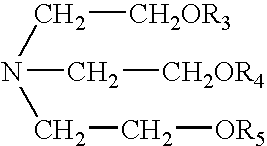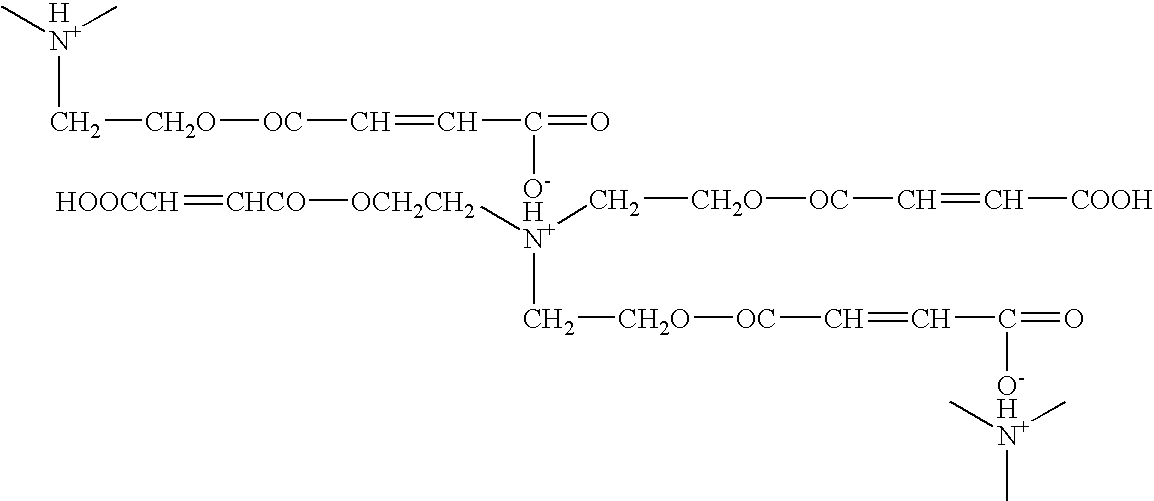Semiconductor flip-chip package and method for the fabrication thereof
a technology of semiconductors and flip-chips, applied in the direction of semiconductor/solid-state device details, soldering apparatus, manufacturing tools, etc., can solve the problems of inability to meet the requirements of the substrate, failure, and poor reliability of the solder joints, and achieve the effect of disassembly from the substra
- Summary
- Abstract
- Description
- Claims
- Application Information
AI Technical Summary
Benefits of technology
Problems solved by technology
Method used
Image
Examples
example 2
[0139] Preparation of tris (maleic acid) triethanolamine monoester: an amine fluxing agent, with the structure: 6
[0140] Three moles of maleic anhydride (294 grams) were heated in a flask at 80.degree. C. until fully melted at which time one mole of triethanolamine (149 grams) was slowly added thereto over the course of one hour, so that gelation did not occur. The composition was constantly stirred and maintained at 80.degree. C. To ensure that the reaction went to completion, the product was maintained at 80.degree. C. with constant stirring for an additional hour. The reactants were kept in a nitrogen atmosphere throughout. Then the product was allowed to cool to room temperature. Monitoring the reaction on a Fourier-transform infrared spectrometer, the OH vibrational band at 3,400-3,500 cm.sup.-1 of the triethanolamine was observed to become minimized while an ester vibration band at 1,710-1,740 cm.sup.-1 appeared and maximized, indicating complete reaction of the triethanolamine...
example 3
[0142] Preparation of methyl meso-erythritol tetramaleic acid monoester:
[0143] 39 g maleic anhydride was heated to 80.degree. C. until all the maleic anhydride was melted before 12.2 g of meso-erythritol was added under mechanical stirring. The temperature was then raised to 130.degree. C. for 30 minutes followed by cooling down to 80-90.degree. C. for 2 hours. The reaction is: 7
example 4
[0144] Preparation of pentaerythritol ethoxylate tetramaleic acid monoester:
[0145] 39 g maleic anhydride was heated to 80.degree. C. until all the maleic anhydride was melted before 27 g pentaerythritol ethoxylate (average Mn ca 270) was added under mechanical stirring. The reactants are stirred at 80.degree. C. for 2-3 hours to complete the reaction. The reaction is: 8
PUM
| Property | Measurement | Unit |
|---|---|---|
| Tg | aaaaa | aaaaa |
| temperature | aaaaa | aaaaa |
| temperatures | aaaaa | aaaaa |
Abstract
Description
Claims
Application Information
 Login to View More
Login to View More - R&D
- Intellectual Property
- Life Sciences
- Materials
- Tech Scout
- Unparalleled Data Quality
- Higher Quality Content
- 60% Fewer Hallucinations
Browse by: Latest US Patents, China's latest patents, Technical Efficacy Thesaurus, Application Domain, Technology Topic, Popular Technical Reports.
© 2025 PatSnap. All rights reserved.Legal|Privacy policy|Modern Slavery Act Transparency Statement|Sitemap|About US| Contact US: help@patsnap.com



